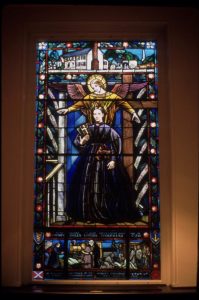Sally Louisa Tompkins: Nurse, Philanthropist, Captain

Throughout history, women have been pushed into extraordinary situations, rising to the challenge and earning their place in the history. Women’s History Month is dedicated to celebrating the perseverance of women throughout history and today as we strive to overcome obstacles in our way. Throughout the Civil War, women were prohibited serving in the armies and at its beginnings were discouraged from serving in the hospitals. Many women throughout the South who had opened their own hospitals were encouraged to close them when Confederate President Jefferson Davis instituted regulations mandating that hospitals be under military command. However, one woman in Richmond, Virginia, named Sally Louisa Tompkins refused to close her hospital and as a result, became the only female commissioned officer in the Confederate Army.
Sally was born in the Tidewater region of Virginia on a farm name “Poplar Grove” in 1833. Not much is documented about her early life, but life was hard on Sally and her family so she had experience with pain and suffering. When she was only five years old, her father, Christopher Tomkins, passed and four years later, three of her sisters, Martha, Harriet, and Elizabeth, succumbed to Yellow Fever within weeks of each other. In her teen years, her family moved to Norfolk where she was educated at the Norfolk Female Institute, then moved to Richmond in 1854 where her mother died shortly after.

Shortly after the Battle of First Manassas on July 21, 1861, Tompkins tried to do what she could to prevent more death by opening a her own hospital in Richmond. Her 1916 obituary published in the Richmond Times Dispatch stated that her hospital was located “at the northwest corner of third and Main Streets, she took her mother’s old cook and opened the hospital ten days after the first battle of Manassas…”. One of many hospitals located within the Confederate capitol, it was rather small having an average of only about 25 patients. It also had several non-military staff members such as the ladies of St. James Episcopal Church, as well as enslaved labors. However, Sally Tompkins had the reputation of being a stickler for cleanliness and so her hospital had one lowest death rates. According to the statistical reports of the Robertson Hospital housed in the National Archives, on average, between 0-4 soldiers passed away each month with no more than seven in a single month. As a result, when Confederate Surgeon General Samuel P. Moore issued an order to close all private hospitals in favor of military hospitals operated by officers, Sally Tompkins fought back. After refusing to close her hospital, President Jefferson Davis had her commissioned as an officer in the Confederate Army so that she could keep the hospital open. On September 9, 1861, Sally Tompkins was officially commissioned as a female Captain in the Confederate Army, yet according to her commission papers, she “would not allow [her] name to be placed upon the pay roll of the army”. Sally’s hospital remained open until the end the Civil War and still had of the lowest mortality rates in Richmond. Out of the 1,334 wounded soldiers that Captain Tompkins’ staff saw, only 73 died.
After the war, Sally remained in Richmond as an active member of the community and St. James Episcopal Church where she continued to focus her life on the service of others. She volunteered as a Sunday school teacher and remained active in a variety of avenues of charitable work. She was also very often recognized for her service during the war. Supposedly several soldiers asked for her hand in marriage, which she turned down remaining unmarried all her life. Additionally, during the 1896 Grand Confederate Reunion in Richmond, she hosted a special patient reunion for the soldiers of the Robertson Hospital. She honored the veterans by paying to rent a house and purchase food for the reunion, and soldiers and their wives from nine southern states came to Richmond to honor her.
Through all of her charitable work, she eventually moved into the Confederate Women’s home in 1905 where she lived until her death in 1916. She was buried with full military honors at Christ Church in Matthews’ County, Virginia.

In her own right Sally Tompkins was just as significant in the medical field during the Civil War as other women like Dorothea Dix, Clara Barton, or Dr. Elizabeth Walker. However, her story seems to be much more localized to the Richmond area than on a national scale. Though her story is not as known, her legacy is prominently displayed in the Richmond area. A marker has stood at the site of the Robertson hospital commemorating Captain Sally since 1910 and in the 1960s at St. James Episcopal Church a stained glass was installed in her honor. Though her story is shorter and not as well known, Sally Tompkins is to be admired for fighting for her desire to keep her hospital open and her willingness to help those in need, both during times of war and peace.

These side stories make ECW great!!
Great article. Those that are on the losing end usually get little recognition. Thanks for posting.
In 1980 Tomkins’ childhood home, “Poplar Grove” in Mathews County, VA was purchased by John Lennon and Yoko Ono, during a time when the couple was investing in multiple East Coast properties. It was just months before before Lennon’s murder, and the couple is said to have stayed there just one night. In 1984 Ono donated the 22-acre estate to New Beginnings Boys Home as ”an apology to the human race and in memory of all war criminals”.
I’m in 5th grade writing essay 500 words thank you this article was my research it got me A thank you!